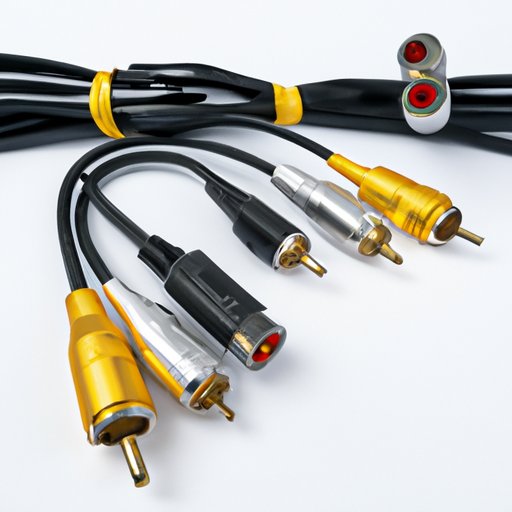Introduction
High Definition Multimedia Interface (HDMI) is an audio/video interface that enables digital audio and video signals to be transmitted over a single cable. It is the most popular connection type for modern home entertainment systems and can be found on almost all new HDTVs, Blu-ray players, gaming consoles, and other devices. But does HDMI carry audio? The answer is yes – HDMI supports up to 8 channels of audio, including Dolby Digital, DTS, and many other formats. In this article, we’ll explore the advantages and disadvantages of using HDMI for audio, as well as how to troubleshoot problems with HDMI audio.

How to Troubleshoot Problems with HDMI Audio
If you’re experiencing problems with your HDMI audio, there are a few steps you can take to try and troubleshoot the issue. First, check your HDMI cables and make sure they are securely connected. If the cables are loose, tighten them and see if that fixes the issue. If not, try connecting a different set of HDMI cables and see if that resolves the problem.
Next, check your TV or receiver settings to make sure the audio output is set to HDMI. If it’s set to something else, change it to HDMI and see if that solves the problem. You should also check the audio settings on your source device (e.g. Blu-ray player, gaming console, etc.) and make sure the audio output is set to HDMI.
Finally, if none of these steps have worked, try resetting your TV or receiver by unplugging it from the wall for a few minutes. This will often clear any temporary glitches and restore normal operation. If you’re still having problems, contact the manufacturer for further assistance.

The Basics of HDMI Audio: What You Need to Know
Before you can understand how HDMI audio works, it’s important to know the different types of HDMI cables available. There are three main types of HDMI cables: standard, high speed, and ultra high speed. Standard HDMI cables can support up to 1080p resolutions at 60Hz, while high speed and ultra high speed cables can support 4K resolution at 60Hz and higher. For best results, use the highest quality cable you can afford.
HDMI also supports a wide range of audio formats, including Dolby Digital, DTS, Dolby TrueHD, and more. To get the best audio quality, make sure your source device (e.g. Blu-ray player, gaming console, etc.) and your TV or receiver both support the same audio format.
A Comparison of HDMI Audio and Other Audio Formats
HDMI isn’t the only way to connect audio components together. Other popular options include optical audio and analog audio. Optical audio is limited to 5.1 surround sound and can only transmit two-channel stereo audio. Analog audio is limited to two-channel stereo and can suffer from interference, noise, and ground loop issues. Both optical and analog audio are also susceptible to signal degradation over long distances.
When comparing HDMI to optical and analog audio, it’s clear that HDMI offers the best sound quality. It supports up to 8 channels of audio, including Dolby Digital, DTS, and other formats. It also supports higher resolutions and longer cable lengths without any signal degradation. However, HDMI cables can be expensive, so if cost is an issue, consider using optical or analog audio instead.

Top Tips for Setting Up Your HDMI Audio System
Once you’ve decided to use HDMI for audio, there are a few things you need to do to ensure a successful setup. First, make sure you’re using the right type of cable. If you’re connecting components that support 4K resolutions, use an ultra high speed HDMI cable. Second, make sure all the components are correctly connected. Check your TV or receiver manual for instructions on how to connect the components properly.
Finally, make sure your source device (e.g. Blu-ray player, gaming console, etc.) is set to the correct audio output. Most devices allow you to select from a range of audio formats, including Dolby Digital, DTS, and others. Make sure you select the audio format that is best suited to your system.
Understanding the Latest HDMI Audio Technologies
In recent years, several new audio technologies have been developed for HDMI, including Enhanced Audio Return Channel (eARC) and Dolby Atmos. eARC is an upgraded version of ARC (Audio Return Channel) that allows for higher bitrates and greater compatibility between devices. Dolby Atmos is a surround sound technology that creates a 3D audio experience with up to 128 distinct audio objects.
Both eARC and Dolby Atmos require compatible hardware and software to work, so make sure your TV, receiver, and source device (e.g. Blu-ray player, gaming console, etc.) all support these technologies before attempting to use them. Additionally, some devices may require additional cables (e.g. optical or coaxial) to process audio signals.
Conclusion
HDMI is a great option for connecting audio components together. It supports up to 8 channels of audio and can transmit audio signals over long distances without any signal degradation. Additionally, it supports a wide range of audio formats, including Dolby Digital, DTS, and others. Finally, newer technologies like eARC and Dolby Atmos can provide an even better audio experience.
Overall, HDMI is a reliable and versatile way to connect audio components together. With the right setup, you can enjoy high quality audio with minimal effort. So if you’re looking for a convenient and reliable way to connect your audio components, consider using HDMI.


